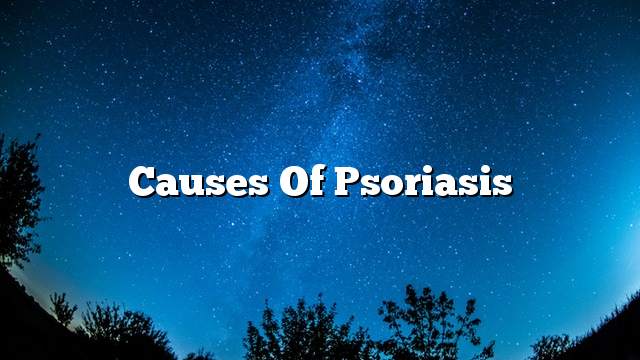The exact cause of the disease is unknown, but genetic predisposition often exists with the environmental factors that motivate it.
There are two methods of genetic transmission:
1- Kind begins at the beginning of youth With a family history of the disease and is associated with HLA significantly
2- Type begins late Of puberty without a family history and its association with HLA is less clear.
If a parent has the disease, the son’s chance is 16 percent. If both parents are infected, the chance of the son’s injury is 50 percent.
Parents with psoriasis are more likely to transmit the disease to their children than their mothers.
If the parents have no psoriasis and have a son who has psoriasis, the chances of infection for the next two children are 10 percent, and the rate of infection in identical twins is 70 percent, while in non-identical twins 20 percent.
In addition to the genetic factor, there are factors that stimulate the emergence of the disease, including:
1. Injuries and trauma such as scratches or surgical wounds.
2 – inflammation: including inflammation of the tonsils with bacteria β-haemolytic strep) and inflammation of the immune system (AIDS)
3 – Hormones: where the disease improves in pregnancy and worsens after, and the lack of calcium in the blood due to lack of thyroid hormone causes the emergence of the disease
4 – Sun rays benefit and improve the disease while the dry atmosphere increases the severity of the disease
5 – Smoking and drinking alcohol: as the disease spread among these categories more
6 – Psychological pressure: where the exacerbation of injury in cases of stress
7 – Drugs: including medicines used in malaria, used for the treatment of pressure (beta blockers), and lithium lead to disease. The withdrawal of drugs such as steroid leads to a return
Psoriasis is a chronic, non-contagious skin inflammation that appears in the form of red spots with silver scales. The most affected areas are the skin of the knees, elbows, the scalp and the lower back area.
2 – The disease spreads in light-skinned people in Europe and North America, the incidence rate is 1-3%, and spread in people aged 15-40.
3. Parents with psoriasis are more likely to transmit the disease to their children than infected mothers
4 – In addition to the genetic factor, there are some factors that stimulate the emergence of psoriasis, including infections and hormones and some medicines and infections (sore throat and AIDS).
5- Psoriasis is divided according to the shape and location of the injury to eight types, namely psoriasis, psoriasis, nail psoriasis, folds, psoriasis, palm rest, psoriasis, psoriasis, psoriasis and redness.
6. The diagnosis of the disease depends on the clinical examination, where the presence of red spots with silver crusts in the spread of the disease.
7. Complications of psoriatic arthritis, secondary infection, increased risk of lymphoma, and increased cerebrovascular disease.
8. Treatment with drugs and radiotherapy includes the use of topical treatment with creams such as cortisone, vitamin D derivatives, A, tar, salicylic acid, radiation therapy such as sun, UVB, oral therapy or injections such as suralin (with UV A), acetretin and methotrexate Cyclosporine and biological materials.
9 – Herbal treatment includes cactus, acetate, red pepper, licorice, fenugreek, walnuts, Brazil, chamomile, the king and other herbs.
1. fitzpatrick’s color atlas and synopsis of clinical dermatology 6th edition
2. Dermatology, Fourth Edition By Richard P.J.B. Weller, John A.A. Hunter, John A. Savin and Mark V. Dahl
3-: //emedicine.medscape.com/
4-herbalremediesworld.com/home-remedies-psoriasis.html
==
==
